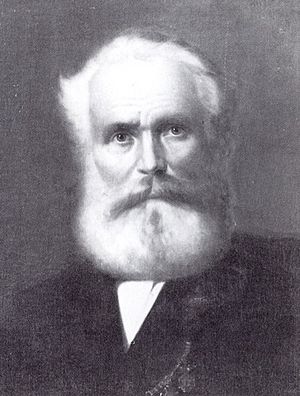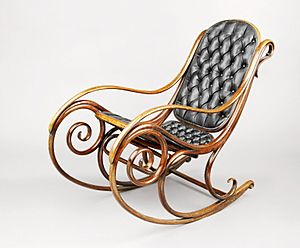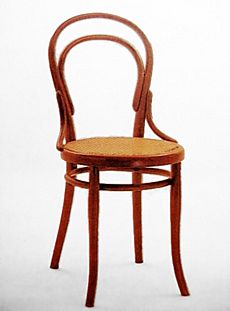Michael Thonet facts for kids
Quick facts for kids
Michael Thonet
|
|
|---|---|

Michael Thonet in his 60s
|
|
| Born |
Michael Thonet
2 July 1796 |
| Died | 3 March 1871 (aged 74) |

Michael Thonet (born July 2, 1796, in Boppard, Germany – died March 3, 1871, in Vienna, Austria) was a German-Austrian furniture maker. He is famous for inventing bentwood furniture. This type of furniture is made by bending wood into curved shapes.
Contents
Michael Thonet's Early Life and Work
Michael Thonet was the son of Franz Anton Thonet, a master tanner. After learning to be a carpenter, Michael Thonet started his own furniture making business in 1819. He married Anna Grahs a year later. They had many children, but only five of their sons lived past early childhood.
How Thonet Invented Bentwood Furniture
In the 1830s, Thonet began trying to make furniture by gluing and bending thin pieces of wood. His first successful piece was the Boppard layerwood chair in 1836. To help with this process, he bought a glue factory in 1837.
Thonet tried to get patents for his new bending method in several countries, but he was not successful at first. His big breakthrough came when he learned how to bend light, strong wood into elegant, curved shapes using hot steam. This new method allowed him to create furniture that was light, strong, and comfortable. It was very different from the heavy, carved furniture popular at the time. His designs are still loved today.
Moving to Vienna and Gaining Fame
At a trade fair in Koblenz in 1841, Thonet met Prince Metternich. The Prince was very impressed with Thonet's furniture and invited him to the court in Vienna. The next year, Thonet showed his furniture, especially his chairs, to the Imperial Family.
Because his business in Boppard faced money problems, Thonet sold it. He then moved to Vienna with his family. There, he and his sons worked on decorating the inside of the Stadtpalais Liechtenstein for Carl Leistler's company. In 1849, Thonet opened his own shop again with his four sons. A few years later, in 1853, he gave the company to his sons. They named it Gebrüder Thonet, which means "Thonet Brothers."
In 1850, he made his famous Nr. 1 chair. At The Great Exhibition in London in 1851, he won a bronze medal for his "Vienna bentwood chairs." This award helped him become known around the world. At the next World's Fair, the Exposition Universelle in Paris in 1855, he won a silver medal as he kept making his production methods better. In 1856, he opened a new factory in Koryčany, Moravia.
The Famous Chair No. 14
The chair Nr. 14 from 1859 is also known as the "Coffee Shop Chair No. 14." Some people call it the "chair of chairs." About 50 million of these chairs have been made, and they are still produced today.
The new bending technique allowed chairs to be made in large numbers for the first time. What was special about the old No. 14 (which is now called No. 214) was that it could be taken apart into just a few pieces. This meant different people could work on different parts. The chairs could be sent all over the world in small, easy-to-ship boxes. For example, 36 taken-apart chairs could fit into a box that was one cubic meter in size. This chair won a gold medal for Thonet's company at the 1867 Paris World's Fair.
The Chair No. 14 helped Thonet become a global company. Many other bentwood furniture pieces followed. Some designs became very famous, like the rocking chair No. 1 from 1860. Later, in the 19th century, models No. 18 and No. 56 were very popular. Around 1900, the elegant No. 209 with its curved armrests was loved by Le Corbusier. In 1904, Otto Wagner designed the Art Nouveau armchair 247, known as the postal savings bank chair. In 1912, Thonet made and sold two million products worldwide, which was their busiest time.
Thonet's Factories and Legacy
In 1857, Michael Thonet's sons, as Gebrüder Thonet, built the first Thonet furniture factory in Koryčany, Moravia, using their father's plans. Over the next few years, five more factories were built in Central Europe. In 1861, Thonet and his sons opened a bentwood furniture factory in Bystřice pod Hostýnem. This factory is still working today, making it the oldest of its kind in the world. In 1889, the seventh and last factory was added in Frankenberg, Hesse, Germany. After World War I and World War II, this factory was the only one still owned by the family. It is still Thonet's main office today.
When Michael Thonet died in 1871 in Vienna, the Gebrüder Thonet company had sales offices all over Europe, as well as in Chicago and New York City. Today, a museum at the factory in Frankenberg shows the history of the company and Thonet's designs.
In 1976, the Thonet company was split into a German company (Thonet GmbH) and an Austrian company (Thonet Vienna). These two companies are now separate. In 2006, Gebrüder Thonet became Thonet GmbH.
Thonet Today
The success of Thonet GmbH in Frankenberg, Germany, started with Michael Thonet's work. Since he opened his first woodworking shop in 1819, the name Thonet has meant high-quality, new, and stylish furniture. Today, Thorsten Muck runs the company from its main office and factories in Frankenberg. Michael Thonet's family, from the fifth and sixth generations, are still involved in the company as partners and sales people.
The company's collection includes famous bentwood furniture and classic tubular steel designs from the Bauhaus period. They also feature new designs by well-known modern architects and designers.
The name "Thonet" is pronounced "toe-net," with a strong "t" sound at the beginning and end.
The Museum of Applied Arts, MAK Vienna has the largest collection of original Thonet chairs in Austria.
|
See also
 In Spanish: Michael Thonet para niños
In Spanish: Michael Thonet para niños


